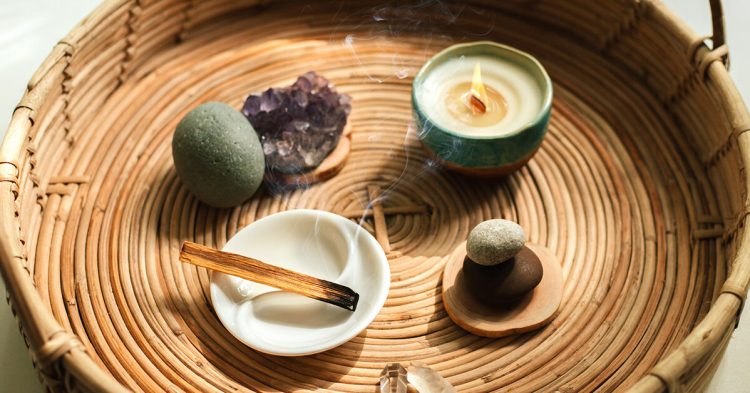Incorporating self-reflection and mindful breathing practices can help you become more mindful and improve your mental health.
You don’t necessarily have to sit yoga style with eyes closed to tap into a state of being more mindful. Every waking hour presents opportunities to enrich your life with mindfulness.
“Many of us go through life on automatic pilot,” says Diana Winston, director of mindfulness education at UCLA’s Mindful Awareness Center in Los Angeles and author of “The Little Book of Being.”
“Mindfulness is when we begin to show up for our lives, really inhabit it, and there’s a sense of greater ease, connection with self, and appreciation of life.”
According to Winston, mindfulness is paying attention to present moment experiences with openness, curiosity, and a willingness to be with what is.
You can begin to cultivate mindfulness for a few minutes each day by meditating somewhere you won’t be disturbed.
This is the starting point, and mindfulness expands from there.
Meditate
Develop a mindfulness practice of meditation. Winston suggests beginners start with just 5 minutes a day and slowly increase to 10 minutes.
Consider the following meditation practice:
- take three deep breaths, in through your nose and out of your mouth
- notice how your body feels
- observe your natural breath without trying to manipulate it
- bring your attention back to your breath when thoughts wander
Daily meditation practice will hone skills that enable you to be mindful in other areas of your life.
Apply mindfulness when needed
Winston recommends an acronym that can help you become more mindful in your daily life.
The acronym “STOP” stands for:
- stop
- take a breath
- observe
- proceed
Once you’ve stopped and connected with your breath, observe what’s happening in your body and mind. Maybe your heartbeat quickens, your stomach turns, or you hear birds chirping or a honking horn.
Paying attention to the most obvious thing that’s happening to you tunes you into the present moment, notes Winston. Once that happens, proceed with your activity with a greater awareness of yourself and your surroundings.
Explore different types of mindfulness
There are many different ways that you can practice mindfulness. When practicing mindfulness, it’s important that you feel comfortable and relaxed. You may try different poses, such as:
You may also consider exploring different environments, such as:
- the beach
- your back yard
- walking in the forest or other natural settings
“It’s not just sitting, and it’s certainly not sitting cross-legged,” that’s a stereotype, says Winston. “It’s much more flexible than that.”
Feet First
When you experience moments of stress, observe your breathing and notice your feet. Take note of how your feet feel and the sensation of the ground under you.
By doing this, you can bring yourself and your thoughts to the present. This can allow you to pause, breathe deeply and connect your mind to your body.
Create a serene space to practice mindful meditation
A special place in your home or office to practice mindful meditation can foster a good daily habit.
You may want to make an altar that serves as a focal point for your practice with an item that evokes a feeling of awareness and transcendence, suggests author Tess Whitehurst in the book “Complete Book of Mindful Living”.
Items to consider are:
- a small statue
- crystals and stones
- flowers
- a holder for incense
- a candle
- inspirational quotes
Reflection
Winston suggests taking time to reflect on the purpose of meditating before entering your practice.
Consider asking yourself why you’re about to practice meditation. Try to accept whatever answer comes to you without judging yourself.
This can help you set an intention for what you want to get out of your meditation. You may find that you seek serenity or greater compassion or wisdom.
Whether lofty or simple, make your intention anything you find meaningful.
Clear Clutter
Let go of things and clutter that no longer serve you.
“You’ll find that clutter is just frozen energy: When it’s just sitting there, it’s heaviness and congestion,” writes Whitehurst. “But when you get it moving, it transforms into lightness, inspiration, and fuel.”
The ability to remain present may help enhance your mood and improve:
- stress levels
- depression
- sense of increased well-being
According to Winston, several clinical treatments for depression, anxiety, and other mental health issues now incorporate mindful-based theory and practice.
Other benefits attributed to a regular practice of mindfulness include:
- increased gratitude
- greater appreciation for life
- sense of being happier and more fulfilled
- improved physical health by boosting your immunity
- alleviate symptoms of chronic pain
7 principles of mindfulness
Dr. Jon Kabat-Zinn developed the following seven key attitudes that support mindfulness practice.
These pillars or principles discussed in his book “Full Catastrophe Living” sprung from Kabat-Zinn’s early work with patients to reduce stress by practicing mindfulness-based self-care.
- Non-judging. Be in the present moment and try not to judge what is happening to you or around you. Focus on the experience and notice how you feel but resist any urge to label it, for example, as good or bad.
- Patience. Be open and curious about mediation and other related mindfulness endeavors. Remember practice takes effort, so seek calmness when frustration or adversity arises. Acknowledge it, but don’t let it derail you.
- Beginners’ mind. Hold no preconceived notions. Observe with fresh eyes and an open heart and mind by taking a beginner’s approach to a new experience.
- Trust. Nourish a basic faith in yourself, your abilities, and what you think and feel. Such trust allows you to accept who you are and that it’s ok to make mistakes.
- Non-striving. Be yourself and let the experience unfold naturally. Don’t try so hard that you miss out or overlook other important feelings or thoughts while meditating.
- Acceptance. Be receptive to seeing things as they are.
- Letting go. Don’t hold onto things you don’t need or thoughts and feelings that might hold you back or block learning and expansion of your practice.
Routinely taking the time to be in the moment and acknowledge the present can profoundly impact your everyday life and relationships.
To improve your state of mindfulness, go somewhere you won’t be disturbed and meditate with focused breathing, bringing your attention back to your breath whenever your thoughts wander.
Daily meditation will sharpen your skills and enhance your quality of attention.
With experience, incorporate mindfulness into your daily life. Consider taking a moment to notice distinct sensations, such as feeling fresh air as you step outside.
Use mindfulness to be creative and curious about the present and what it reveals about the internal and external you.
Source by psychcentral.com


